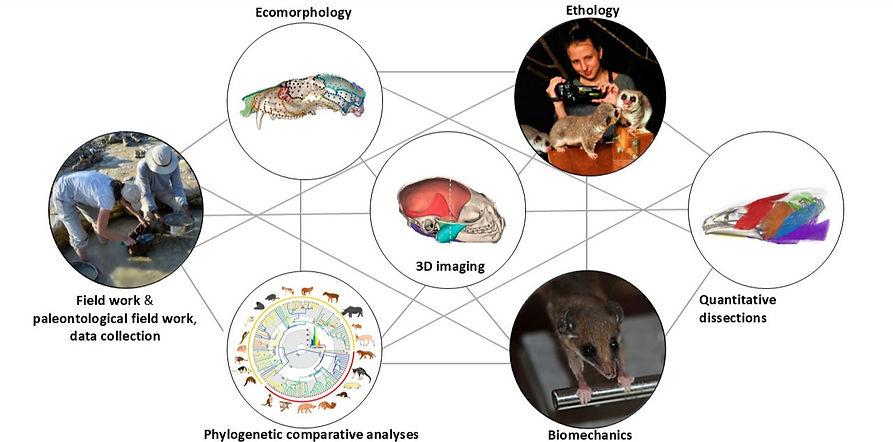
Our Research
Our research group focuses on the origin and evolution of morphological and functional diversity of organisms, mostly vertebrates. A major goal of our research is to disentangle the impact of the internal (e.g., development) and external (e.g., environment, climate) factors shaping past and current phenotypic diversity of organisms and how these relate to function. We aim to understand and explain the vast morphological diversity in the natural world and its significance to an organism’s ecology.
Aside from our work on extant species, we also used our skills to make more robust inferences of the paleobiology of extinct taxa allowing a better understanding of the origin and evolution of past and current diversity. Our research takes place at different taxonomic (from population to species level) and temporal (current and past diversity) scales. We address questions such as the impact of ecology on the diversity in form and function; how development may be a driver of morpho-functional diversification; how morphological variation translates into variation in function and behaviour; the importance of in vivo data on extant species to shed light on the paleoecology of extinct species.
Our group is particularly cross-disciplinary as we integrate techniques and methods from functional morphology to quantify variation in function; geometric morphometrics to quantify morphological variation; paleontology to incorporate past morphological diversity; ethology to quantify behavioural diversity; development to understand how life cycle variation may foster morphological and functional variation; ecology to quantify the habitat use or diet of a species; phylogenetic comparative methods to incorporate evolutionary history and its dynamics allowing us to quantitatively test our hypotheses and understand which factors foster morphological and functional diversity.
Our research is firmly embedded in the field of functional morphology and evolutionary biology, combining specimen-based work with in vivo studies (in zoos and in the field) and quantitative analyses of the musculoskeletal system (bone and muscles) in the context of function (feeding and locomotion), behavior, and life history traits in a comparative phylogenetic framework.
Our main scientific contributions and research activities are:
1) Development as a driver of biodiversity
Recently, we started to investigate the impact of developmental strategies on morphological and functional diversity. Indeed, the diversity of developmental strategies offers an excellent framework to study morphological and functional diversity as animals that metamorphose change in morphology and ecology during their lifetime. Almost all the successful and species-rich lineages in the animal kingdom have a complex life cycle and experience metamorphosis, transforming an individual from a larva into an adult.
Given that species with complex life cycles have the genetic and developmental machinery to drastically change their morphology and ecology during their lifetime, these species can be expected to also show greater phenotypic plasticity, and may consequently be capable of responding flexibly to changes in their environment. As such, our lab is trying to understand whether life cycle variation has played a major role
in shaping past and current biodiversity and will generate predictive models to assess future diversity.
2) Environmental constraints can generate or constrain the evolution of phenotypic variation.
Similar morphologies are not produced randomly and can be the result of evolutionary constraints, where the constraint is a character property and not the property of a lineage. In this case, morphological evolution can, for example, be the result from past evolutionary history. Understanding how challenging environments (arboreal, aquatic, fossorial, etc) affect organismal shape and thus performance is an intrinsic part of our research. Many substrates (but not all) can be traversed by animals with different skeletal forms and it is thus primordial to characterize function. Studying function is necessary as selection acts on the functional output of a morphological system which is directly relevant to the fitness of an animal. Moreover, the relationships between form and function are not direct as many morphologies may give rise to the same functional output. In the group, we study how non-related species evolve similar morphologies under similar environmental constraints.
3) Reconstructing the paleobiology of extinct species, by understanding the interplay between bones and muscles in relation to function.
The group works on understanding the factors that shape diversity in form in relation to function in order to make more robust inferences on fossil taxa. To understand the vast morphological diversity and its significance to an organism’s ecology, we focus on the feeding and locomotor systems in tetrapods (amphibians, squamates, birds, and mammals). This approach has allowed us to isolate the different factors that influence the evolution of these systems.


